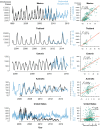Digital epidemiology reveals global childhood disease seasonality and the effects of immunization
- PMID: 27247405
- PMCID: PMC4914188
- DOI: 10.1073/pnas.1523941113
Digital epidemiology reveals global childhood disease seasonality and the effects of immunization
Abstract
Public health surveillance systems are important for tracking disease dynamics. In recent years, social and real-time digital data sources have provided new means of studying disease transmission. Such affordable and accessible data have the potential to offer new insights into disease epidemiology at national and international scales. We used the extensive information repository Google Trends to examine the digital epidemiology of a common childhood disease, chicken pox, caused by varicella zoster virus (VZV), over an 11-y period. We (i) report robust seasonal information-seeking behavior for chicken pox using Google data from 36 countries, (ii) validate Google data using clinical chicken pox cases, (iii) demonstrate that Google data can be used to identify recurrent seasonal outbreaks and forecast their magnitude and seasonal timing, and (iv) reveal that VZV immunization significantly dampened seasonal cycles in information-seeking behavior. Our findings provide strong evidence that VZV transmission is seasonal and that seasonal peaks show remarkable latitudinal variation. We attribute the dampened seasonal cycles in chicken pox information-seeking behavior to VZV vaccine-induced reduction of seasonal transmission. These data and the methodological approaches provide a way to track the global burden of childhood disease and illustrate population-level effects of immunization. The global latitudinal patterns in outbreak seasonality could direct future studies of environmental and physiological drivers of disease transmission.
Keywords: Internet search; chicken pox; disease dynamics; forecast modeling; vaccination.
Conflict of interest statement
The authors declare no conflict of interest.
Figures



References
Publication types
MeSH terms
Substances
LinkOut - more resources
Full Text Sources
Other Literature Sources
Medical

